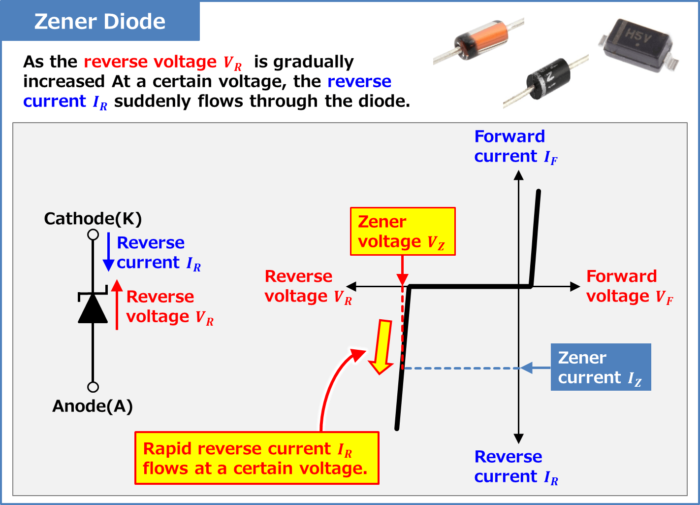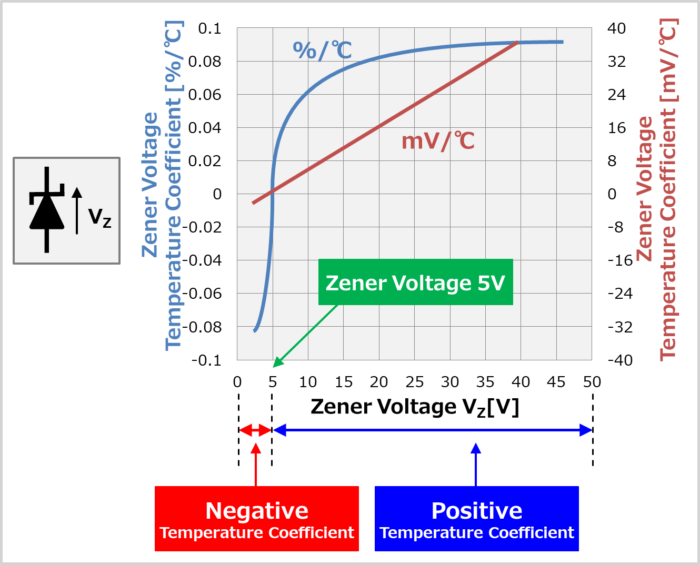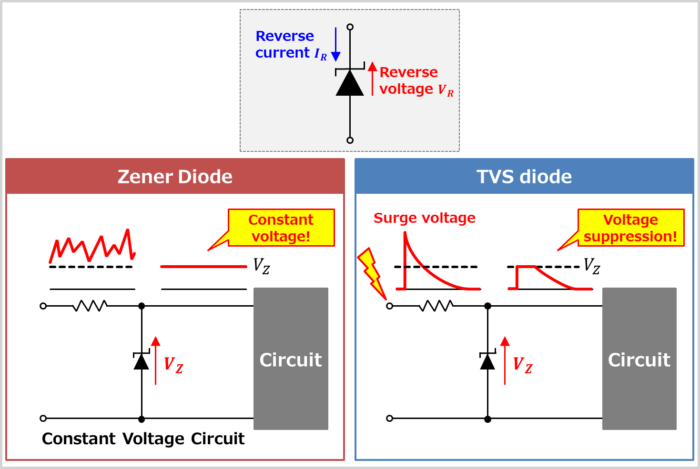Regarding the "Zener Diode", this article will explain the information below.
- What is a Zener Diode?
- Characteristics, Symbols, and Applications of Zener Diodes
What is a Zener Diode?

A zener diode is a diode in which the reverse current \(I_R\) flows rapidly at a certain voltage when the reverse voltage \(V_R\) is gradually increased.
The reverse voltage \(V_R\) is the voltage when positive is applied to the cathode and negative to the anode. Also, the current \(I_R\) is the current flowing from the cathode to the anode.
The phenomenon in which the reverse current \(I_R\) flows rapidly at a certain voltage as the reverse voltage \(V_R\) applied to the zener diode is increased is called the "breakdown".
The reverse voltage \(V_R\) at which the reverse current \(I_R\) begins to flow rapidly is called the zener voltage (breakdown voltage) \(V_Z\). The reverse current \(I_R\) flowing at this time is called the zener current \(I_Z\).
In a zener diode, the zener voltage \(V_Z\) does not change much when the zener current \(I_Z\) changes. Zener diodes are often used in constant voltage circuits to take advantage of this characteristic.
Supplement
- In a normal diode, the forward current \(I_F\) flows from the anode (A) to the cathode (K).
- The forward characteristic is almost the same as that of an ordinary diode. Therefore, when a forward voltage VF of about 0.7 V is applied, the forward current IF begins to flow.
- Zener diodes are also called reference diodes.
Zener Diode Symbols

To distinguish zener diodes from ordinary diodes, a circuit symbol with a "Z" like symbol on the cathode is used, as shown in the figure above.
There are two types of triangles, "filled" and "unfilled," but either can be used.
Circuit symbols with an "L" like symbol may also be used, but are less common.
Temperature Characteristics of Zener Diode

Depending on the magnitude of the zener voltage, a zener diode may have a positive or negative temperature coefficient.
Those with a Zener voltage higher than around 5V have a positive temperature coefficient, so the zener voltage increases as the temperature rises.
On the other hand, those whose zener voltage is lower than around 5V have a negative temperature coefficient, so the zener voltage decreases as the temperature rises.
In addition, the positive and negative temperature coefficients cancel each other for zener diodes with a zener voltage near 5V, resulting in a small temperature change.
Related article
The following article explains the "Temperature Characteristics of Zener Diode" in detail. If you are interested, please check it out from the link below. 続きを見る
Temperature Coefficient of Zener Diode
Applications of Zener Diode


Zener diodes are often used in constant voltage circuits because of the characteristic that the zener voltage \(V_Z\) does not change much when the zener current \(I_Z\) changes.
By connecting a zener diode to the front of a circuit or component, a constant voltage can be supplied to the circuit or component.
Zener diodes are also used to protect circuits and components from surge voltages such as static electricity by taking advantage of their feature of conducting when a voltage exceeding the zener voltage \(V_Z\) is applied. Zener diodes used in such applications are called "TVS diodes" or "ESD protection diodes.
Supplement
- The circuit symbol for a TVS diode is the same as for a zener diode.
Summary
In this article, the following information on the "Zener Diode" was explained.
- What is a Zener Diode?
- Characteristics, Symbols, and Applications of Zener Diodes
Thank you for reading.
Related article
"Information about Zener diodes" is explained in detail in the following articles. If you are interested, please check it out from the link below.